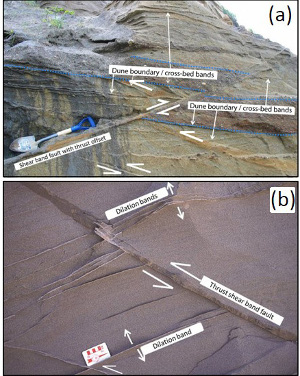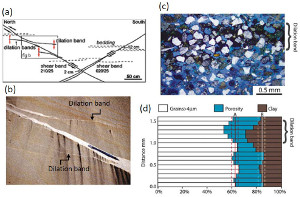| |||||||
|
|
|||||||
|
|
|||||||
| Fractures in McKinleyville, CA, USA | |||||||
|
Cashman and Cashman (2000) and Du Bernard et al (2002) reported multiple sets of deformation bands in poorly consolidated sand, gravel, and mud deposit of late Pleistocene age exposed in the 83 ka Savage Creek marine terrace near McKinleyville,NW of the town of Arcata in northern California (see Figure 1 for location map). The bands occur in the footwall of the McKinleyville thrust: Two apparent conjugate sets of bands dipping approximately 30 degree in opposite directions and a third set of nearly sub horizontal bands (Figure 2).
The two sets of inclined shear bands consistently offset bedding laminations in a reverse sense. Single shear bands are a few grain diameter thick with slip of 1 to 5 mm. Also exist zones of shear bands with tens of centimeters offsets. The third set of sub-horizontal bands is parallel or shallowly inclined to bedding along a direction that roughly bisects the conjugate sets of shear bands (Figures 2, 3 and 4). The sub-horizontal bands are 1 to 2 mm or 5 to 10 grain diameter thick. They are always spatially associated with shear bands, frequently originating at their tips and extending into their extensional quadrants (Figures 3a, b and Figures 4a and b). Sub-horizontal bands in some places cut across but do not offset inclined markers such as cross beds, unconformities and channel fills indicating that the bands form in predominantly opening-mode in response to slip along the inclined shear bands. These are identified as 'Dilation Bands' by Du Bernard et al. (2002) and thus being the type locality for this type of localized deformation. In polished thin sections, shear bands are characterized by grain rotation and translation and little grain fracturing. See the photomicrograph presented under 'Mechanisms and Mechanics of Shear Bands'. Grain rotation and translation resulted in porosity reduction and preferred orientation of elongate grains parallel to the shear bands. Remaining pore space is preferentially filled with clay, predominantly kaolinite, chlorite, iron oxides, and organic matter. Sub-horizontal bands are identified in thin-section by an increased abundance of pore filling clay forming meniscus cement bridges across neighboring grains (Figures 4c and d). It is determined by point-counting, the abundance of detrital grains within sub-horizontal bands decreases by up to 7%±3% relative to the grain abundance outside of bands marked by line 'A' in Figure 4d. The 7% reduction in detrital grain abundance correlates with an increase in clay abundance of 9%±3% with respect to the clay abundance outside the bands (line 'B'). Based on intact clay bridges across grains in sub-horizontal bands, it was inferred that the clay cement is largely a diagenetic product resulting from mineral alteration and infiltration that occurred after band formation. The subsequent precipitation and infiltration of clays may have prevented collapse of deformation-induced dilatancy after reverse slip on the inclined shear bands has seized. | |||||||
| Reference: |
|||||||
| Cashman, S., Cashman, K., 2000 Du Bernard, X., Eichhubl, P., Aydin, A., 2002 Eichhubl, P., Muller, J.R., Aydin, A., |
|||||||
|
Readme | About Us | Acknowledgement | How to Cite | Terms of Use | Ⓒ Rock Fracture Knowledgebase |
|||||||



